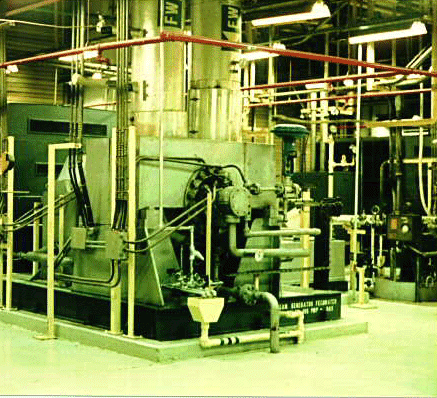The Virtual Nuclear Tourist !!! Nuclear Power Plants Around the World Turbine Building - Main Feedwater Pump |
The Virtual Nuclear Tourist !!! Nuclear Power Plants Around the World Turbine Building - Main Feedwater Pump |
 |
The Feedwater Pump may be electrically or turbine-driven. In this case, a large electric motor is located on the left hand side of the photo. The pump increases the water pressure from about 350 pounds per square inch (psi) to about 1200 pounds per square inch. Plants typically will have 2 or 3 Feedwater pumps. Often the pump shaft rotates at a speed of over 5000 RPM. For the pump above, water is being supplied by the large right hand pipe, and leaving from the large left hand pipe.
Photo by J.A. Gonyeau |
| The Feedwater Pumps take a suction from both the Condensate
and Heater Drains Systems. Condensate is routed from the condenser, where the steam from
the low pressure turbine is condensed to water in a vacuum. Condensate pumps raise the
pressure to over 350 psi. Typically the Condensate water passes through 4 to 6 stages of
heater drain coolers and Feedwater heaters which recover heat from steam exhausted from
the various turbine stages and heat the Condensate water temperature from 90F to
approximately 350F. The Condensate passes on the inside of tubes in the Feedwater heaters;
the heater drains pass on the outside of the tubes (shell side) of the heat exchangers. The Feedwater pumps raise the pressure to about 425 - 450 psi. The water then passes typically through 1 stage of High Pressure Feedwater heater. After passing through the HP Feedwater heater, the water is at about 425F and then passes to through regulating, or control, valves and then to the steam generator in the PWR, VVER, CANDU, and RBMK designs. In the case of the BWR, the water is supplied to the reactor. |
|
Copyright © 1996-2011. Virtual Nuclear Tourist. All rights reserved. Revised: Saturday April 02, 2011